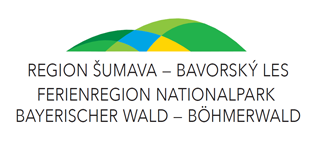4 – Remains of the Golden Road above Modrava
The trail of the Golden Road turns by the boarding house Rendlová in Filipova Huť into the “Preisleithe” forest and leads to Modrava. Its remains can be seen from stepping into the forest. There is a sunken lane which continues all the way to the northeast side of Modrava, for 1250 m. It is joined by another rail from the west and there is an old junction between the two rails. In the final part, just before Modrava, signs of other rails appear as well.
The trail of the Golden Road just passes a modern residential place northeast above Modrava and leads into the road from Kvilda to Filipova Huť, just before the edge of Modrava. Not far from here is a modern concrete cross (above Klostermann’s lodge).
The Hussite wars at the beginning of the 15th century and the following long unrest of the post-hussite and Poděbrad era paralysed trade on the Golden Road. The Bavarian-Bohemian border witnessed many armed and bloody dispute among the restless west-bohemian nobility and this made trade conditions much worse. The catholic magnates House of Rožmberk and the city of České Budějovice took advantage of this and moved a large portion of salt and other trade to their land around Vltava, from Vyšší Brod to Budějovice. A revival of trade on the Golden Road and Trail happened during the 16th century
Area, nature, personalities, events
Man and the biodiversity of Šumava
Human colonisation greatly increased the biodiversity of Šumava by deforesting parts of land and using them as fields, meadows and pastures. By this, men allowed the existence of non-forest species, who often formed non-indigenous yet valuable communities. They are usually meadow species. These non-forest meadow formations with varied needs and level of management are of vital importance to the maintenance of current biodiversity of the National Park. From a botanical point of view, this is the basic starting point from which the philosophy of the plan to care for these exceptional environments must spun.
The Hussite wars at the beginning of the 15th century and the following long unrest of the post-hussite and Poděbrad era paralysed trade on the Golden Road. The Bavarian-Bohemian border witnessed many armed and bloody dispute among the restless west-bohemian nobility and this made trade conditions much worse. The catholic magnates House of Rožmberk and the city of České Budějovice took advantage of this and moved a large portion of salt and other trade to their land around Vltava, from Vyšší Brod to Budějovice. A revival of trade on the Golden Road and Trail happened during the 16th century
Area, nature, personalities, events
Man and the biodiversity of Šumava
Human colonisation greatly increased the biodiversity of Šumava by deforesting parts of land and using them as fields, meadows and pastures. By this, men allowed the existence of non-forest species, who often formed non-indigenous yet valuable communities. They are usually meadow species. These non-forest meadow formations with varied needs and level of management are of vital importance to the maintenance of current biodiversity of the National Park. From a botanical point of view, this is the basic starting point from which the philosophy of the plan to care for these exceptional environments must spun.
After the end of the Golden Trail and the Golden Road
Not far from here, on the right side, stands a modern concrete cross, which could be a successor to a cross mentioned by A. Brzorád in his description of the Golden Road. In Summer of 1882, this forest geodesist walked through the Bohemian part of the road, between the border and Horská Kvilda, and published his findings. A. Brzorád captured the basic and most characteristic feature of medieval trade routes in a mountainous terrain. This meant mainly the attempt to avoid wet and waterlogged areas, even if it means steeper ascent.
Not far from here, on the right side, stands a modern concrete cross, which could be a successor to a cross mentioned by A. Brzorád in his description of the Golden Road. In Summer of 1882, this forest geodesist walked through the Bohemian part of the road, between the border and Horská Kvilda, and published his findings. A. Brzorád captured the basic and most characteristic feature of medieval trade routes in a mountainous terrain. This meant mainly the attempt to avoid wet and waterlogged areas, even if it means steeper ascent.


